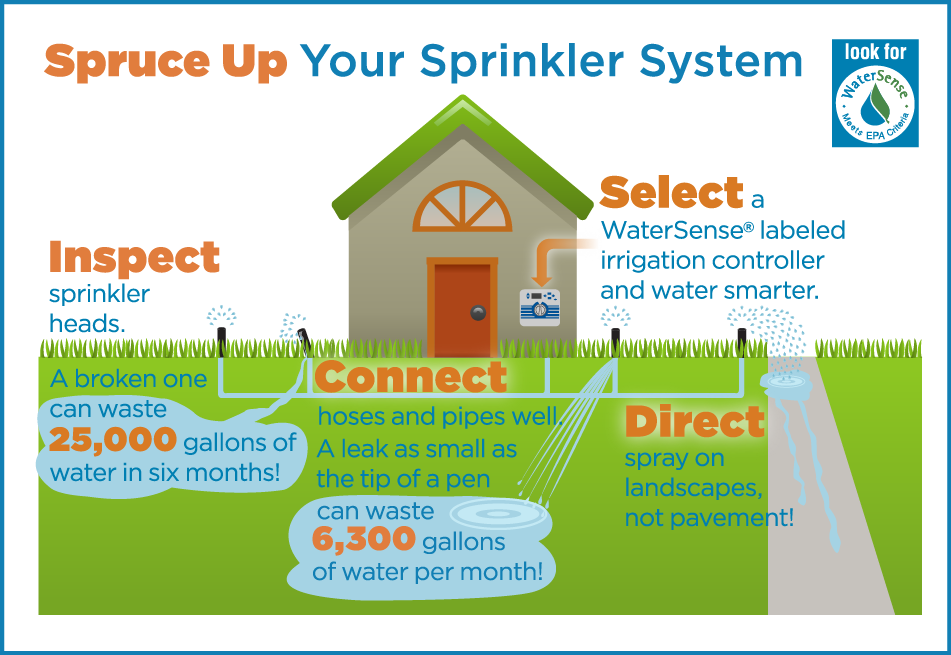 For a printer-friendly version, please see our Fast Facts guide.
For a printer-friendly version, please see our Fast Facts guide.
Water is one of the few commodities people cannot live without, and it is also a commodity many of us may take for granted. Consumers can easily reduce water usage without sacrifice by following a few simple steps. These are some of the tips that can add up to significant savings on your bill, while helping to protect a critical resource.
- Make Sure Your Home or Business is Leak-Free
Leaky faucets, pipes or toilets can waste significant amounts of water and money.
Check all faucets to make sure they do not leak or drip, including any outdoor spigots.
- A faucet that drips once per second and goes unrepaired for a month wastes nearly 260 gallons of water.
- If the same faucet goes unrepaired for a year, the wasted water will add up to more than 3,100 gallons.
- Example 1: If a customer is billed at a rate of $1.75 per 1,000 gallons, a 3,100 gallon leak will add $5.43 to the customer’s bills.
- Example 2: For the customer who is billed $7.00 per 1,000 gallons, the same leak would cost $21.70. (Such a leak would also increase the customer’s sewage bill, if it is also calculated on the amount of water used.)
- A faucet that drips once every 3 seconds wastes 86 gallons of water per month.
- A typical home uses approximately 5,000 gallons of water per month.
Leaky faucets can be fixed inexpensively. Hardware stores, plumbing supply stores and home maintenance books can help.
Checking toilets for leaks is very easy.
- Put a few drops of food coloring in the toilet tank and wait 15 to 20 minutes before flushing. If any food coloring shows up in the bowl before you flush, you have a leak.
- Flush quickly after finishing the test to keep from staining the bowl.
Toilet leaks can waste hundreds of gallons per day if left un-repaired. However, fixing them is usually simple and inexpensive.
An unusually high bill may indicate a leak in your underground supply line. The customer usually owns and is responsible for the part of the service line between the meter and the building.
- In The Bathroom
Check toilets for leaks on a regular basis.
A toilet manufactured before 1994 may use thousands of gallons more per year than newer models. Consider either installing a new toilet or placing a “toilet dam” in the tank. If placed properly, a toilet dam can save hundreds of gallons each year.
- A toilet dam can be a plastic shield (available from a hardware or plumbing supply store) or a homemade device (such as a plastic bottle filled with pebbles). The point is to take up space in the tank or block off a portion so that that it requires less water.
- Toilet dams should never interfere with flushing/plumbing mechanisms, and should be checked regularly to ensure that they do not.
- A brick, if placed in a toilet tank, can release chemicals into the water that may damage the flushing mechanisms.
When purchasing a new toilet, look for the EPA WaterSense label. WaterSense labeled toilets use at least 20 percent less water than standard toilets on the current market, while meeting specific performance criteria.
Do not put trash in the toilet. This not only wastes water, but may also cause problems in sewage systems and septic tanks.
A water-efficient showerhead will pay for itself in a few months.
Taking showers instead of baths will save significant amounts of water. Consider taking shorter showers.
Install flow restrictors in faucets.
Do not leave the faucet running when brushing teeth or shaving.
- These actions may also reduce sewer bills while lowering energy bills related to heating the water.
- In The Kitchen
When washing dishes:
- Run the dishwasher only when fully loaded.
- Use the economy setting on the dishwasher (if it has one).
- Many newer models of dishwashers offer different cycles, allowing you to use them most efficiently.
- An energy-efficient dishwasher is likely to be water-efficient.
- If you wash dishes by hand, fill the basin with soapy water and quickly rinse the dishes under a slowly moving stream from the faucet.
- Depending on the type of dishwasher you own, hand washing may not necessarily be more efficient.
Garbage disposals require large amounts of water. Consider composting food or putting it in the garbage, instead.
If you run the faucet while waiting for water to get hot, consider collecting it in glasses or a pitcher instead of pouring it down the drain. The collected water can be used for other things, such as watering plants, drinking, etc.
If you want cold drinking water, keep a pitcher in the refrigerator.
Do not use running water to thaw meat or other frozen foods. Defrost food in the refrigerator or in your microwave.
- Around The Home or Business
Insulate your water heater and maintain it regularly, following the manufacturer’s instructions.
Insulate your hot water pipes. If the water stays warm while in the pipes, you will not have to run as much water to get it to the desired temperature.
Wash only full loads of clothing and set your washing machine to the proper water level. Remember that many newer washing machines offer water-efficient features.
Energy-efficient appliances are likely to be water-efficient, too. When shopping for appliances, look for the Energy Star label.
Look for water-efficient models when buying a filtering or water softening system.
Locate the master shut-off valve in your home or business. Be prepared to use it in case of a burst pipe or other emergency.
- Outdoors
Water the lawn efficiently, and learn more about home lawn irrigation from Purdue University.
- Water in the early morning or after dark to minimize evaporation. The best time, generally, is between 4:00 a.m. and 8:00 a.m. unless your utility requests otherwise.
- Water only when necessary. (If you walk across the grass and leave footprints, your lawn needs to be watered.)
- Do not water on windy days or just after it has rained.
- Avoid using a sprinkler that sprays a fine mist.
- Adjust sprinklers to only water the lawn and not the building, sidewalk or street.
- If you use an underground sprinkler system:
- Learn about new technology for automatic systems, including sensors and "smart controllers" that can turn the system off if the soil has had enough water.
- Turn it off when it rains (especially if it is on a timer).
- Maintain it regularly. Check valves for leaks. Check sprinkler heads regularly and adjust them as needed.
- Adjust it to meet seasonal demands.

Raise your lawn mower blade to the highest setting, especially during dry weather. Closely cutting the grass makes roots work harder, requiring more water.
When washing the car, use soap and water from a bucket. Use a hose with a shut-off nozzle for the final rinse.
Use a broom to clean off your driveway. If you must use a hose, use one with a high-pressure, on/off nozzle.
Properly-done landscaping can save water.
- Plant in the spring or autumn.
- Check with your local nursery for recommendations on trees, shrubs and plants that need less water.
- Using a layer of mulch around plants can reduce evaporation and promote plant growth.
- Line Protection Programs
Some water utilities may offer a “line protection program” for a monthly fee that acts as “insurance” for underground supply lines. A supply line brings the water from the utility’s main to an individual home or business and is typically the customer’s responsibility. Utilities are generally responsible for lines between main and the meter. If such a program is available and you consider enrolling, make a careful and informed decision, read all of the fine print, and consider the likelihood of leaks in or damage to your supply lines. If you live in a rental property, consult with your landlord and review your lease before enrolling. Landlords are typically responsible for utility lines on their properties.
The OUCC offers more information on line protection programs at www.in.gov/oucc/2656.htm.
You may also be interested in...
